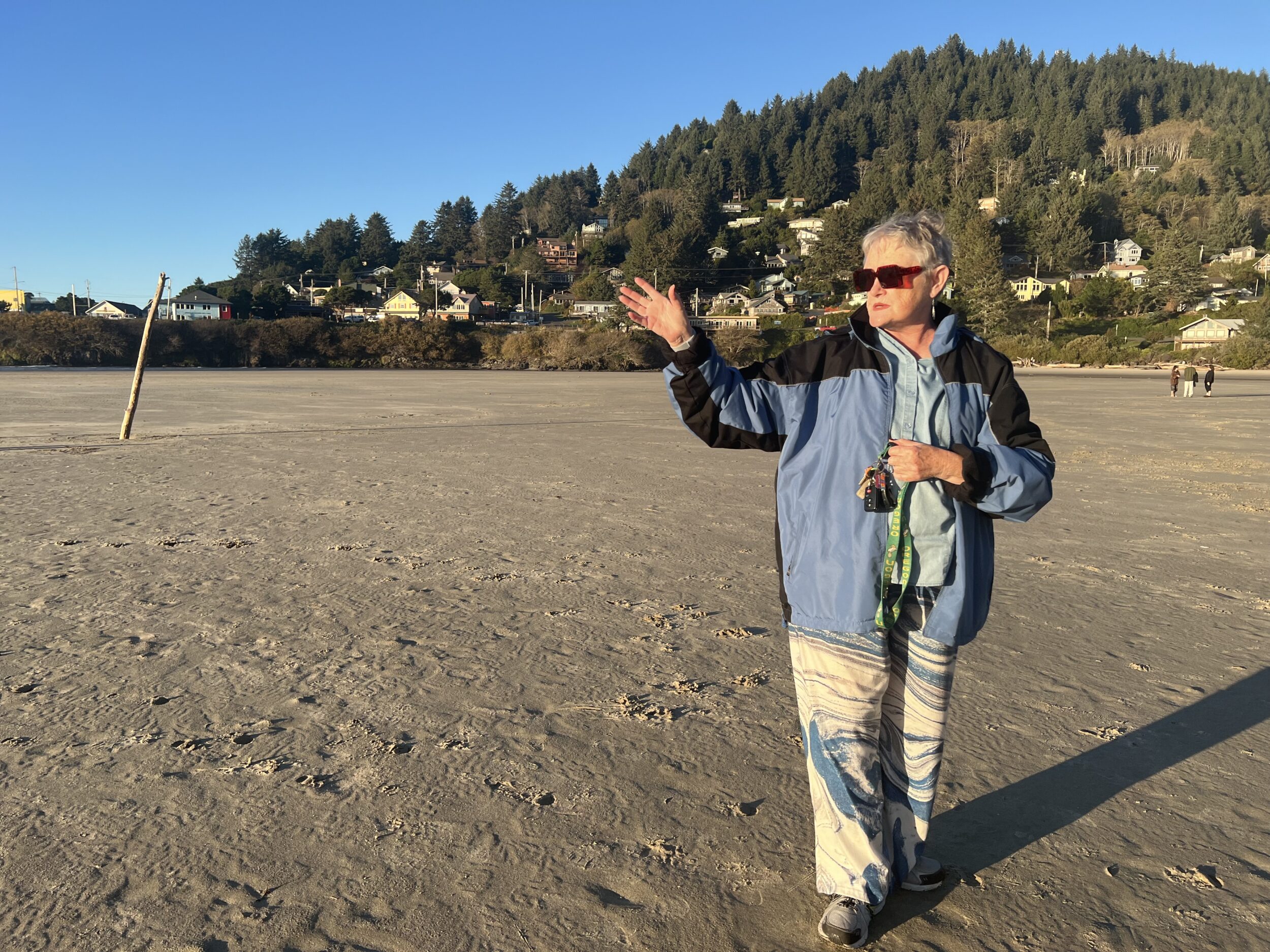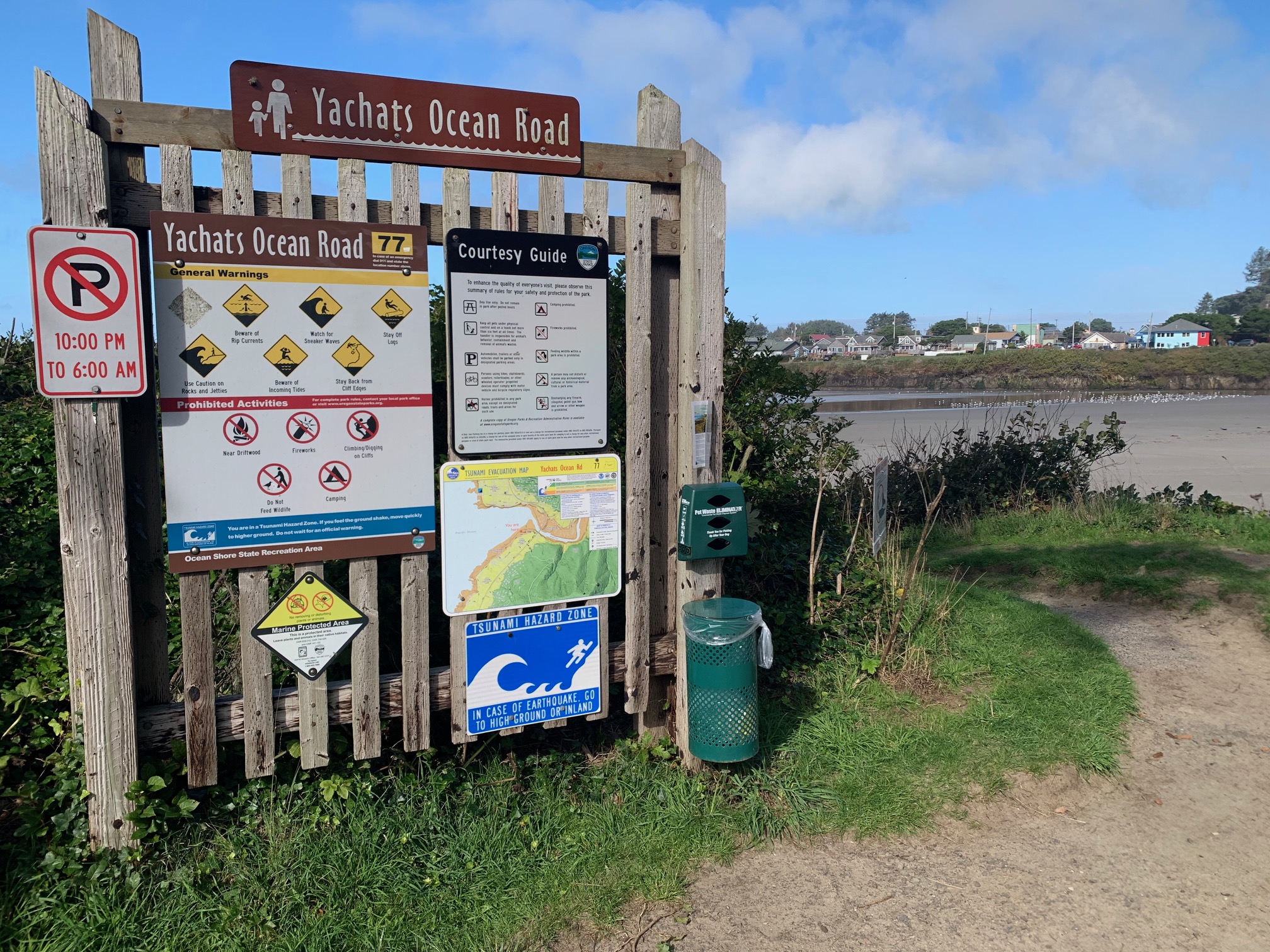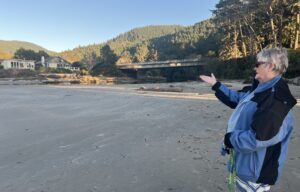
By SUSAN PALMER/YachatsNews
Ann Dwyer didn’t see the sneaker wave that almost killed her and her granddaughter on a calm October day one year ago.
Dwyer, a retired Eugene psychiatrist, and her granddaughter had stepped onto the big sandy beach where the Yachats River flows into the Pacific. They arrived a little after noon, about 45 minutes after low tide. Dwyer’s granddaughter was chattering about jumping over little wavelets coming up on the beach and Dwyer was looking down at the 4-year-old child.
Then the wave hit them. It was at least waist high on Dwyer, knocking her down and hurling her granddaughter away from her and toward the river.
“We were walking down the beach. The first wave broke three feet ahead of us,” Dwyer said. “The second wave was the sneaker wave.”
She and her granddaughter didn’t get dragged out into the open ocean because of the quick response of other beachgoers that day.
Last year, YachatsNews interviewed Angela Wynia, the Portland resident who pulled Dwyer’s granddaughter from the water. But Dwyer, a very private person, hasn’t spoken about it publicly until now. She came forward because she feels too many people don’t recognize the danger.
“If I could save a single life with this story, it’s worth it,” she said.

Sneaker waves kill a few people every year on beaches from northern California up through southern Washington. They are a feature unique to Pacific Northwest beaches because of the local topography and the way storms sweep across the Pacific.
Determining data on the number of deaths and injuries is challenging because of the various agencies that respond to the emergencies. But Oregon State University researchers dug into the numbers from 2005 to 2017 and concluded that 29 fatalities could be attributed to sneaker waves in those 12 years — 15 in Oregon and 14 in northern California.
“Sneaker waves don’t get a lot of attention, but people die in ones and twos every year,” said Tuba Özkan-Haller, dean of Oregon State University’s College of Earth, Ocean, and Atmospheric Sciences.

Özkan-Haller is a nearshore oceanographer and coastal engineer. Her team of researchers have studied the phenomenon, collaborating with the National Weather Service in an effort to better predict their likelihood.
YouTube videos of sneaker waves that hit many Pacific Northwest beaches on Jan. 16, 2016 are responsible for initiating some of the OSU research, Özkan-Haller said.
Researchers scoured the internet for videos from that date and their subsequent work offered a new insight. Sneaker waves emerge as forerunners of storms far out in the Pacific and headed toward the coast. They arrive before the storms do when the weather is mild and people are more likely to be on beaches.
They are seasonal, most likely to occur between October and April. The tides also have an impact on sneaker waves, which can ride a high tide even further inland than they might otherwise travel. Sneaker waves have crested sand dunes and seawalls and run up streets in coastal towns, as many of the YouTube videos revealed.
While they are colloquially known as sneaker waves, researchers call them “runup events” because they don’t look like a classic wave breaking a little offshore.
“They can feel and look like a river,” Özkan-Haller said. “The water keeps on coming.”

The power of waves
That’s what happened on the Yachats beach, Dwyer said. While she herself wasn’t aware of it, Wynia, who rescued Dwyer’s granddaughter, told her the water just kept rolling in. Dwyer estimated that it dragged her granddaughter the length of two football fields away from her.
“It was seconds and she was screaming and it was more and more distant and the sound of the waves made it very hard to hear, but I heard her and it dawned on me, if she’s screaming she’s breathing. But I couldn’t get up. I absolutely could not get up. I didn’t understand until later that the reason you can’t get up is the sand in your clothes. It’s like concrete,” she said.
It’s the second surprising thing about sneaker waves. They don’t look like waves and they are full of sand.

And it’s this aspect that increases the risk, especially for beachgoers wearing boots or waders, said Lt. Cmdr. Pete Harrington, command center chief at the Coast Guard Columbia River Sector in Portland. People fishing or clamming often wear chest-high waders that strap over their shoulders. When they throw a coat on over the shoulder straps it makes getting out of the waders in an emergency that much more difficult.
“You never know what the ocean’s going to do and it’s a lot stronger than you think it is,” Harrington said. “Even six inches of water is enough to knock you off your feet.”
Being weighed down by sand and water in a notoriously frigid Pacific Ocean increases the risk. “When you’re in the water, seconds matter,” Harrington said.
Dwyer was so weighed down by sand it took two other adults who came to her rescue to help her stand up. Her granddaughter was so weighed down with sand that Wynia, who plucked her from the water, could barely lift her, Dwyer said.
Dwyer herself struggled to climb the stairway up to the parking area because of the added weight.
Even though she shook out her clothes at home in the garage before washing them, the sand was deep in both the washer and dryer when she cleaned them. It sluiced off her in clumps when she showered and she was still picking tiny particles out of her teeth a week after the incident.

King tide and sneaker wave season
The variety of coastal environments means that sneaker waves pose a range of risks. People walking on jetties, even when they look dry, can be swept off them. Massive logs that look like they aren’t going anywhere can be lifted in just a few inches of water, moving and crushing or trapping people. Beachgoers walking near steep rocky cliffs can be flung against them.
Oregon is well into sneaker-wave season and with three king tides coming this winter, the danger increases. The occasional alignment of the sun, Earth and moon when the moon’s orbit is closest to the Earth and the Earth’s orbit is closest to the sun, result in king tides. The first occurs this weekend and then again Dec. 13-15 and Jan. 11-13.
In some locations king tides may not be much different than a usual high tide. In others, they may flood low-lying areas.
Brian Fowler, who manages the parks from Newport to Yachats for the Oregon Parks and Recreation Department and is also a surfer, wants visitors to the coast to enjoy the tremendous power of the ocean while also respecting it.
“I really want people to come and witness a cool environmental phenomena, but I also want people to be as prepared as possible,” Fowler said. “Know your tides, know your exit route, have an emergency plan. And if there are 55 mph winds or additional rain, that’s only going to heighten that king tide. So think about how much more inundated (the beach) could be.”
Anyone who has spent time on Oregon beaches is familiar with signs warning of sneaker waves, and most folks are familiar with the adage: “Never take your eyes off the ocean.”
But for Dwyer, the signs and adage are woefully lacking. She’d like to see signs that show a phone number or link to the National Weather Service site. That agency offers warnings when sneaker waves are likely to occur.
She has other recommendations, too:
- Don’t go to the beach alone and don’t wear blue jeans, which are much heavier when soaked than synthetic fiber clothing;
- Carry a walking stick so if you do get hit by a wave, you have three points of contact with the ground not just two, and
- Watch for waves that are more brown than ocean gray as they may be sneaker waves.
Others offer this safety advice:
- Take 10 to 20 minutes before going down to the beach to time the crests between waves. If they’re getting longer than 22 seconds apart, it might be wise to stay off the beach;
- Consult a tide table for your location and be aware that water can regularly reach the top of jetties as high tide approaches;
- Stay away from logs on beaches as they are waterlogged and heavy and yet can float in just a few inches of water, moving around and often trapping people;
- Avoid areas where you could be trapped by rushing water, such as rocky cliffs; and
- Have a strategy to get off the beach in 15 to 20 seconds should a sneaker wave approach.
For Dwyer, the experience has changed how she thinks about her visits to the coast. She describes the conversation she had with her granddaughter the day after they almost died.
“She said, ‘Do you think that there’s a sea monster who did that?’ I said, ‘Honey I don’t think there’s sea monsters, but I think the ocean can be a monster. You have to really respect its power.”
- Susan Palmer is a Eugene-based freelance writer. Visit her blog at susanpalmer.org
To see what sneaker waves look like, check these video links.
https://www.sfgate.com/news/article/sneaker-wave-Oregon-coast-coos-bay-video-6784462.php
For details on the OSU research go here.
For more information on sneaker wave safety go here.



Comment Policy